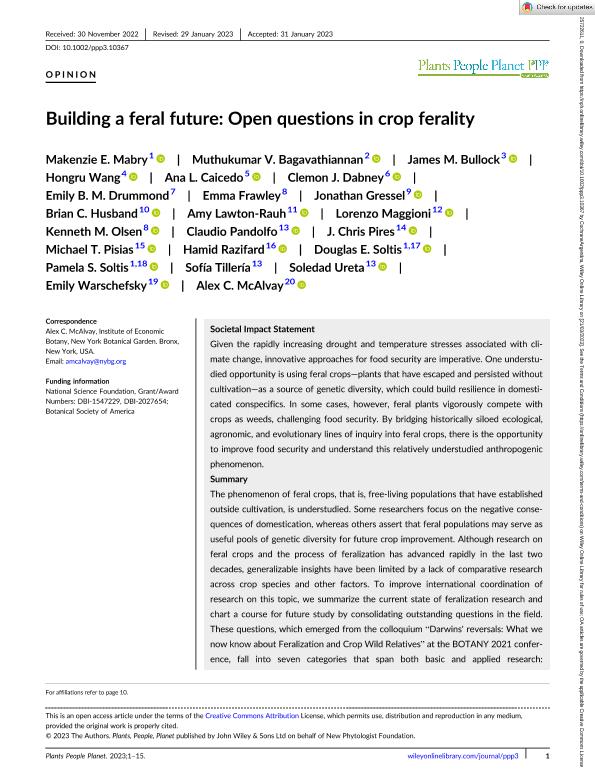Artículo
Building a feral future: Open questions in crop ferality
Mabry, Makenzie E.; Bagavathiannan, Muthukumar V.; Bullock, James M.; Wang, Hongru; Caicedo, Ana L.; Dabney, Clemon J.; Drummond, Emily B. M.; Frawley, Emma; Gressel, Jonathan; Husband, Brian C.; Lawton Rauh, Amy; Maggioni, Lorenzo; Olsen, Kenneth M.; Pandolfo, Claudio Ezequiel ; Pires, J. Chris; Pisias, Michael T.; Razifard, Hamid; Soltis, Douglas E.; Soltis, Pamela S.; Tillería, Sofía Gabriela
; Pires, J. Chris; Pisias, Michael T.; Razifard, Hamid; Soltis, Douglas E.; Soltis, Pamela S.; Tillería, Sofía Gabriela ; Ureta, Maria Soledad
; Ureta, Maria Soledad ; Warschefsky, Emily; McAlvay, Alex C.
; Warschefsky, Emily; McAlvay, Alex C.
 ; Pires, J. Chris; Pisias, Michael T.; Razifard, Hamid; Soltis, Douglas E.; Soltis, Pamela S.; Tillería, Sofía Gabriela
; Pires, J. Chris; Pisias, Michael T.; Razifard, Hamid; Soltis, Douglas E.; Soltis, Pamela S.; Tillería, Sofía Gabriela ; Ureta, Maria Soledad
; Ureta, Maria Soledad ; Warschefsky, Emily; McAlvay, Alex C.
; Warschefsky, Emily; McAlvay, Alex C.
Fecha de publicación:
03/2023
Editorial:
John Wiley & Sons
Revista:
Plants People Planet
ISSN:
2572-2611
e-ISSN:
2572-2611
Idioma:
Inglés
Tipo de recurso:
Artículo publicado
Clasificación temática:
Resumen
Societal Impact Statement: Given the rapidly increasing drought and temperature stresses associated with climate change, innovative approaches for food security are imperative. One understudied opportunity is using feral crops—plants that have escaped and persisted without cultivation—as a source of genetic diversity, which could build resilience in domesticated conspecifics. In some cases, however, feral plants vigorously compete with crops as weeds, challenging food security. By bridging historically siloed ecological, agronomic, and evolutionary lines of inquiry into feral crops, there is the opportunity to improve food security and understand this relatively understudied anthropogenic phenomenon. Summary: The phenomenon of feral crops, that is, free-living populations that have established outside cultivation, is understudied. Some researchers focus on the negative consequences of domestication, whereas others assert that feral populations may serve as useful pools of genetic diversity for future crop improvement. Although research on feral crops and the process of feralization has advanced rapidly in the last two decades, generalizable insights have been limited by a lack of comparative research across crop species and other factors. To improve international coordination of research on this topic, we summarize the current state of feralization research and chart a course for future study by consolidating outstanding questions in the field. These questions, which emerged from the colloquium “Darwins' reversals: What we now know about Feralization and Crop Wild Relatives” at the BOTANY 2021 conference, fall into seven categories that span both basic and applied research: (1) definitions and drivers of ferality, (2) genetic architecture and pathway, (3) evolutionary history and biogeography, (4) agronomy and breeding, (5) fundamental and applied ecology, (6) collecting and conservation, and (7) taxonomy and best practices. These questions serve as a basis for ferality researchers to coordinate research in these areas, potentially resulting in major contributions to food security in the face of climate change.
Archivos asociados
Licencia
Identificadores
Colecciones
Articulos(CERZOS)
Articulos de CENTRO REC.NAT.RENOVABLES DE ZONA SEMIARIDA(I)
Articulos de CENTRO REC.NAT.RENOVABLES DE ZONA SEMIARIDA(I)
Citación
Mabry, Makenzie E.; Bagavathiannan, Muthukumar V.; Bullock, James M.; Wang, Hongru; Caicedo, Ana L.; et al.; Building a feral future: Open questions in crop ferality; John Wiley & Sons; Plants People Planet; 5; 5; 3-2023; 635-649
Compartir
Altmétricas



